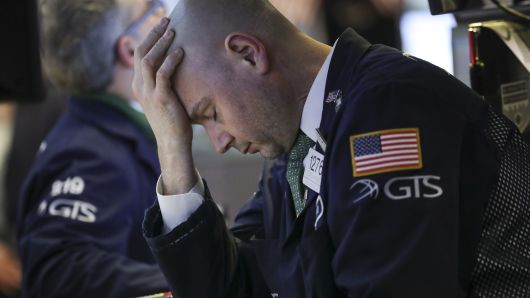Markets are trying to turn negative, and I don’t understand why.
Economists weigh both inflationary data and expectations for inflation. Psychological attitudes have always been recognized as being important, and market psychology made a glaring attempt to turn negative last week. Tweets from President Donald Trump and comments from TV talking heads including DoubleLine’s Jeff Gundlach suggested that with the December rate hike, the Federal Reserve has overstepped and killed economic growth and doomed us to recession.
The evidence was the inversion of the Treasury yield curve at the short end. Indeed, bills were yielding more than notes. Of the last 14 inversions of the yield curve, nine have led to recessions, while five have not.
The sudden hue and cry is what I don’t understand. I’ve long suggested that the weakness in share prices last fall and winter were a rational repricing of more modest long-term growth expectations. We went from 4 percent GDP growth to expectations of a prolonged 2 percent growth environment.
Earnings growth estimates for S&P 500 companies have gone from around 20 percent a year ago to 4 percent to 5 percent this year and next. That’s a big deal, though much of the 20 percent growth spike was the result of the corporate tax cut. Paying less in taxes allowed companies to post higher earnings. Moreover, I’ve long said that economic and market growth could not withstand meaningfully higher interest rates. And we don’t have them.
After more than 30 years in the investment business, I can always make a plausible bull or bear argument for the short-term. Long-term, I’m always bullish.
Why so negative?
Why the negativity now? Current data didn’t suddenly collapse last week. In fact, after a negative January, housing data improved big time. Interest rates are very low. This can be viewed positively and negatively.
The positive view is that money is inexpensive and available for growth and investment. The negative view is that rates are low because money is racing into bonds and not into any of those vehicles that might produce better returns because future expectations for growth are so bleak.
Employment in the U.S. is very high. Workers are in demand, and wages are rising. The negative view is that higher wages will reduce corporate profit margins. The positive view is that for the first time in 20 years, wages for the average consumer are increasing relative to inflation, and the consumer will be soon able to foment organic demand. Give the U.S. consumer cash, and it gets spent. We buy stuff better than almost anyone else in the world.
There is precious little inflation. I attended a closed-door luncheon of thought-leading economists and market strategists two weeks ago who puzzled over this no-inflation question. Possible explanations were the Amazon effect, ample low-cost labor from India and China, and a strong dollar. All are plausible reasons and likely true in part. It is also likely that there is much more to the current economic swing.
Each winter and spring, I travel around the country giving talks on my economic and market forecast. This year’s title is “Unintended Consequences.” After 10 years of quantitative easing and fiscal stimulus in the U.S. and around the world, regulators and central bankers can cheer their success at avoiding deep recessions and depressions.
That many of the fiscal and monetary tools have never been used to this extent and for this long suggests to me that there are other consequences that may be less apparent and may be years in their discovery. My basic conclusion has been that slow growth for the next few years seems reasonable. Lackluster and boring, but not awful.
I believe that markets could as logically conclude that the Federal Reserve may have gotten it right. Maybe this return to slow growth isn’t a recessionary crash; maybe it’s just a slowdown during which wage growth will continue to increase and organic demand will build to fuel real (not central bank-driven) growth. Productivity from technological advances could round out a rosy forecast.
Three phases of the market
As with most things dealing with economic and market forecasts, no one has any real idea of what’s happening until well after it has happened, and we certainly have no idea about what will really happen in the short-term.
My concern is that this recent, negative interpretation of long-extant data may be self-fulfilling. There are three psychological stages to any bull or bear market: denial, acceptance, and fear or exuberance. No one appears as silly and ridiculous as the optimist amid a crisis — even a faux crisis. Do I sound bullish to you? If I do, does that strike you as silly and unconsidered? Sadly, hand-wringers always seem to garner greater credibility.
I’m not particularly bullish, but I’m not bearish either. With rates this low and the Federal Reserve moving more to the sidelines and perhaps closer to another stimulative phase, there isn’t any immediate guillotine ready to fall.
Longer-term I have an incredible dread of the explosive amount of debt that is now increasing at a rate of more than $100 billion per month. Modern Monetary Theory that says debt no longer matters in a zero-rate environment is among the more moronic notions I’ve heard in 30 years.
Circling back, it is tough to tell whether this passionate rush to embrace Eeyore will take hold. I hope not, but I encourage cooler, calmer heads to reflect on the abundance of positive data that suggest that while things may be far from great, they aren’t awful.
Commentary by Michael K. Farr, president of Farr, Miller & Washington and a CNBC contributor. Follow him on Twitter
@Michael_K_Farr
.
For more insight from CNBC contributors, follow
@CNBCopinion
on Twitter.

